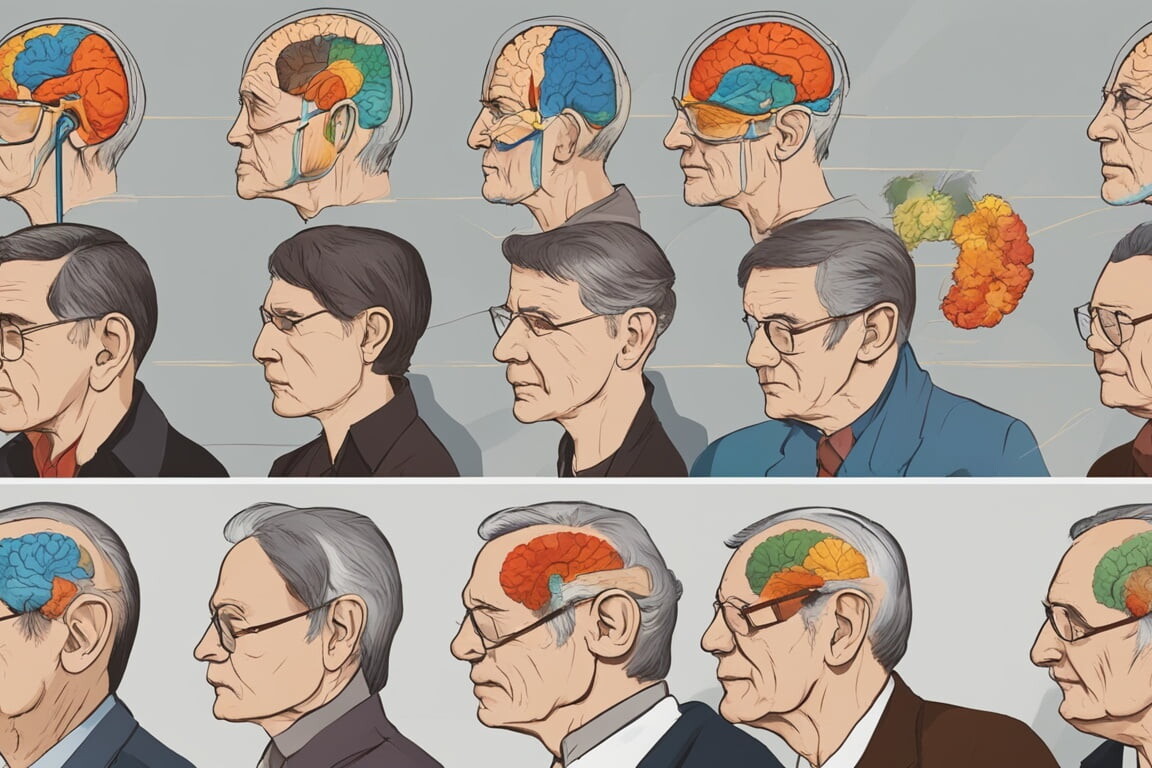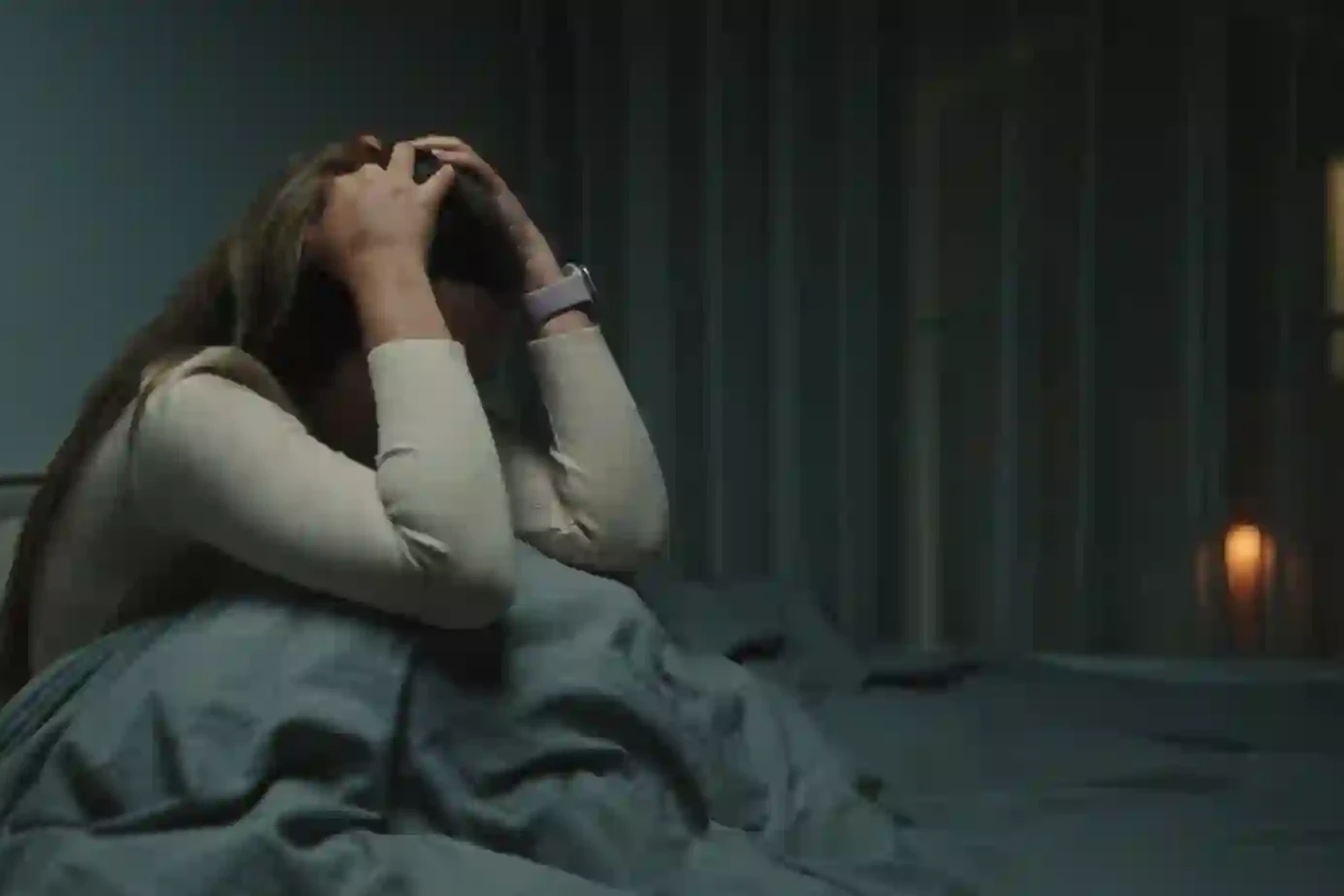Frontotemporal dementia (FTD) is a group of disorders. They happen when nerve cells in the brain’s frontal and temporal lobes are lost. This makes the lobes shrink. FTD changes behavior, personality, language, and movement. It’s common among younger people, with symptoms often appearing between the ages of 40 and 65.
FTD has common types like the frontal variant and primary progressive aphasia. The frontal variant changes how a person behaves and their personality. Primary progressive aphasia affects how you communicate. There are also rare types that affect movement, being similar to Parkinson’s or ALS. We’re not entirely sure what causes FTD, but some cases are due to genetic mutations. The disease gets worse over time, but the speed of decline depends on the person.
Frontotemporal dementia is both complex and devastating. It severely affects a person’s life. Knowing about its symptoms, causes, and how it progresses is key to offering good care. In this article, we will look into what frontotemporal dementia is, its common symptoms, and the various types of the condition.
Table of Contents
ToggleIntroduction to Frontotemporal Dementia
Definition and Overview
Frontotemporal dementia (FTD) is a group of brain disorders. It happens when nerve cells in the front and side parts of the brain die. This makes these areas shrink. This shrinking can change how a person acts, thinks, speaks, and moves. It is common among younger people, often between 40 and 65 years old.
Causes and Risks
Frontotemporal dementia is still a mystery in many ways. We don’t completely know what causes it. Yet, we do know some things. For example, certain genes, like those found on chromosomes 3, 9, and 17, play a role.
The genes PGRN and MAPT, found on chromosome 17, are important for FTD. Anyone can get FTD, and it often shows up between 40 and 65. But it can begin even later. Surprisingly, over half of those with FTD have no family history of it. This hints that sometimes it appears for unknown reasons.

| Statistic | Value |
|---|---|
| Occurrence in Dementia Patients | 5-15% |
| Rank Among Degenerative Dementias | 3rd most common |
| Onset Age Range | 21 to 81 years |
| Typical Onset Age | 45 to 65 years |
| Mortality Timeline | 6-8 years |
| Family History Prevalence | 40-50% |
Types of Frontotemporal Dementia
Frontotemporal dementia has three main types: behavioral variant, primary progressive aphasia, and motor function issues like ALS. Knowing these types helps doctors make the right diagnosis and plan treatment.
Behavioral Variant Frontotemporal Dementia (bvFTD)
Behavioral variant frontotemporal dementia is most common. It causes changes in how a person acts, feels, and handles emotions. People with this type may seem uninterested, stop caring about others, do things that aren’t socially okay, or ignore keeping clean. Between 10 and 30% of bvFTD cases come from specific genes.
Primary Progressive Aphasia (PPA)
Primary progressive aphasia mainly affects how a person communicates. It has two forms: one makes words lose their meaning over time, and the other makes speaking difficult. The first type, semantic variant, makes people forget the words’ meanings. The non-fluent variant makes it hard to talk. People might start speaking very simply. Eventually, they might even stop talking.
About 1 in 5 FTD cases have the semantic variant of PPA, and about 1 in 4 have the non-fluent type. It is key for healthcare providers to understand these types to offer the right treatment. This is also true for behavioral variant frontotemporal dementia and other PPA forms.
What is Frontotemporal Dementia? Symptoms and Progression
Common Symptoms
Frontotemporal dementia (FTD) affects people in different ways. It mainly depends on which part of the brain is changed. People might show behavior and personality changes. This could be acting in ways that are not normal, not caring about others’ feelings, being too direct, or not taking care of themselves. Problems with language, like not finding the right words or understanding them, are also common.
Progression and Stages
This disease gets worse as time goes by. How fast it progresses can vary a lot. Some might live over 10 years after diagnosis, and others might live only two. About 60% of those with FTD are between 45 and 64 when they start showing symptoms.
Frontotemporal dementia includes quite a few symptoms. These can be strange behaviors, emotional issues, trouble talking or understanding, problems at work, or walking difficulties. It usually happens at a younger age than other dementias. The two common types are bvFTD and PPA.

BvFTD is when personality, actions, and decisions change a lot. Other rarer types can affect how you move. They might cause stiff muscles, trouble keeping balance, and eye movement issues.
Genes can also be behind FTD. Changes in genes like Tau, GRN, and C9ORF72 can start FTD. Around 10 to 30% of bvFTD cases come from these gene changes.
Diagnosis and Treatment
Diagnosing frontotemporal dementia is tough. This is because its signs can look like other brain diseases. Doctors do many tests to find out the real cause of the symptoms.
Diagnostic Process
Finding out if someone has frontotemporal dementia involves exams and tests. Doctors might look at the brain using images like MRIs. They also check the spinal fluid.
This thorough check helps doctors figure out what type of dementia it is. It also shows which part of the brain is affected.
Management and Treatment Options
Right now, there is no cure for frontotemporal dementia. But, doctors and scientists are working on ways to help. They focus on making life better for people with FTD.
People might take medicine to handle their behaviors or mood. Therapy for the speech can also help. It makes communication easier. Doing exercises and changing the home a bit can make daily life better too.
Taking care of a loved one with FTD is hard work. Caregivers are very important in helping them. It’s key for them to take care of themselves too. Joining support groups and using local services can help in this role.

Living with Frontotemporal Dementia
Caregiver Support
Frontotemporal dementia (FTD) makes life tough for the patient and their family. Caregivers have a big job in helping. But, they must also care for themselves. Learning about FTD and finding support groups are key steps for caregivers. Use community help like home care nurses and social workers. This will make daily life easier and lower stress.
Planning for the Future
Looking ahead is very important with FTD. As the disease gets worse, more care will be needed. This might mean 24-hour nurse care or living in a special place. Caregivers should talk with doctors and plan for what’s next. This includes making legal, financial, and end-of-life plans. Planning now helps ensure the best care for your loved one as the disease goes on.
Conclusion
Frontotemporal dementia (FTD) is a difficult disease that impacts the brain’s lobes. It alters behavior, personality, language, and motion. Though the main causes remain a mystery, several genetic factors may play a role. FTD ranks as the third most common dementia after Alzheimer’s and Lewy body diseases, affecting 5-15% of dementia patients.
Usually, it starts showing effects between the ages of 45 and 65, but age ranges widely. The disease tends to get worse with time, leading to death within 6-8 years. Notably, about half of people with FTD have a family history of it. And, studies have found certain areas on chromosomes linked to the disease.
Handling and treating FTD is still a big challenge. But, ongoing research is trying to better grasp the problem and find ways to help. By keeping up with the latest news on frontotemporal dementia, you can plan ahead for potential difficulties. This way, you may also help improve the life quality of those with this condition.
FAQ
What is frontotemporal dementia?
Frontotemporal dementia (FTD) is a brain condition. Nerve cells in two lobes at the front and sides of the brain die. This makes the lobes shrink. It changes your actions, who you are, how you talk, and how you move.
What are the common symptoms of frontotemporal dementia?
The symptoms can be different for each person. They show which part of the brain is affected. You might see changes in how a person acts and feels. This can mean they don’t care, can be too direct, or act without thinking.
Not caring about looking clean can also happen. Talking and understanding words might become hard too. These are common signs.
What are the different types of frontotemporal dementia?
There are three main types. The frontal variant changes behavior and personality. Primary progressive aphasia makes communication hard. Less common forms can affect movement, looking like Parkinson’s disease or ALS.
What causes frontotemporal dementia?
Scientists are still learning about the cause. Some cases are because of gene changes. FTD gets worse over time, but it’s different for everyone.
How is frontotemporal dementia diagnosed?
There’s not a single test for diagnosing FTD. Doctors do many tests. They check the body and brain, do thinking tests, and look at brain images. These help rule out other illnesses.
How can I support a loved one with frontotemporal dementia?
Dealing with FTD is very tough for both patients and those who care for them. Learning about the disease is helpful. Supporting groups and community help also make a big difference.
What is the prognosis for frontotemporal dementia?
FTD keeps getting worse over time. The rate of decline is different for each person. Some genetic factors may play a role in developing this disease.
Source Links
- https://www.nia.nih.gov/health/frontotemporal-disorders/what-are-frontotemporal-disorders-causes-symptoms-and-treatment
- https://www.hopkinsmedicine.org/health/conditions-and-diseases/dementia/frontotemporal-dementia
- https://www.mayoclinic.org/diseases-conditions/frontotemporal-dementia/symptoms-causes/syc-20354737
- https://www.ncbi.nlm.nih.gov/pmc/articles/PMC3038533/
- https://www.alz.org/alzheimers-dementia/what-is-dementia/types-of-dementia/frontotemporal-dementia
- https://www.alzheimers.org.uk/about-dementia/types-dementia/frontotemporal-dementia
- https://www.mayoclinic.org/diseases-conditions/frontotemporal-dementia/diagnosis-treatment/drc-20354741
- https://www.nia.nih.gov/health/frontotemporal-disorders/providing-care-person-frontotemporal-disorder
About The Author

This article is medically reviewed by Dr. Chandril Chugh, Board-Certified Neurologist, providing expert insights and reliable health information.
Dr. Chandril Chugh is a U.S.-trained neurologist with over a decade of experience. Known for his compassionate care, he specializes in treating neurological conditions such as migraines, epilepsy, and Parkinson’s disease. Dr. Chugh is highly regarded for his patient-centered approach and dedication to providing personalized care.
→ Book a consultation to discover which remedies suit your needs best.




